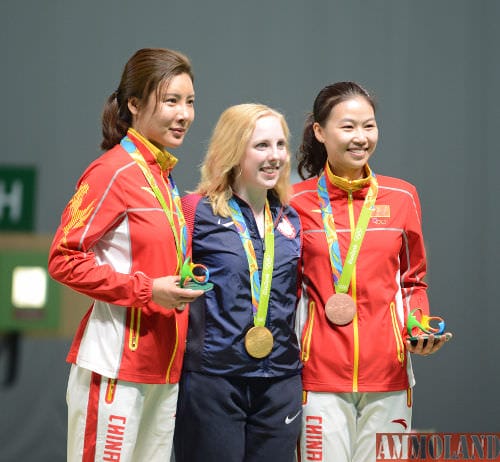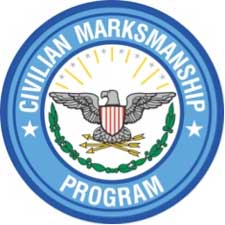By Gary Anderson, CMP Director Emeritus


Camp Perry, OH -(AmmoLand.com)- Three-Position Air Rifle shooting is one of the most popular youth shooting programs in America.
Its massive participation base includes more than 2,000 JROTC programs in schools, hundreds of 4-H Shooting Sports clubs and several hundred junior rifle clubs. An estimated 250,000 to 300,000 youth participate annually in three-position air rifle programs, with most of them engaging in some form of organized competitive shooting. The main governing body for this massive youth sports program is the National Three-Position Air Rifle Council. The primary means of governance is the Council’s rulebook, the National Standard Three-Position Air Rifle Rules.
The National Standard Rules are revised and reissued on a bi-annual basis. The newest version of the Rules, the 11th 2016-2018 edition, has just been released. An electronic version of the new 3-position rules is posted on the CMP website at https://thecmp.org/air/national-standard-three-position-air-rifle-rules/.
There are only a few real rule changes that will come into effect for the next two-year rules cycle, but there are a number of rules updates and clarifications. The Council tries to keep 3-position rules coordinated with ISSF rules (International Shooting Sport Federation rules that govern Olympic and international shooting competitions) because some of the best USA junior 3-position air rifle athletes will advance to compete in USA Shooting and ISSF competitions. Some Council rule changes followed 2017 ISSF rule changes while some were deemed to be not appropriate for USA junior competitions.
Input from coaches, parents, athletes and match sponsors regarding possible rule changes was solicited though a CMP Shooters News article that was posted on 14 April. Several comments and suggestions were received and the National Council reviewed all of them when it met at Camp Perry on 13 July. Many of those recommendations were incorporated into the 2016-2018 rules.
The importance and impact of National Three-Position Air Rifle Council programs and 3-position air rifle shooting recently received a big affirmation when USA shooting athlete Ginny Thrasher, a 19-year-old West Virginia University sophomore, won the first gold medal of the 2016 Olympic Games in Rio de Janeiro. Thrasher has been an active participant in junior 3-position air rifle competitions, attended CMP junior rifle summer camps in 2012 and 2013 and earned Junior Distinguished Badge #771 in 2014.
Here is a summary of the rule changes in the 2016-2018 National Standard Rules. Anyone who has questions about any 3-position rules should contact National Council Secretary Vicki Donoho at vdonoho@thecmp.org or 419- 635-2141, ext. 702.
- 2.4 Definition of Loading. This rule clarifies that “a rifle is considered loaded when a pellet contacts the rifle.” This means a rifle is considered loaded when a pellet is placed on the loading port, even if the bolt is not closed.
- 3.2 Team Eligibility. Team eligibility determination procedures have been changed. The previous requirement that any team with a member who lives more than 75 miles from the team base must obtain an eligibility ruling from the National Council has been dropped. There is now a uniform procedure that requires team leaders or coaches to sign a Team Eligibility Declaration Form when they enter their teams. A model Team Eligibility Declaration Form is printed in the rulebook and can be copied and used by match sponsors. The club or team membership requirement is increased to 90 days prior to a competition, but there are exceptions for new athletes who just started shooting or whose families moved to the new residence.
- 4.2.4 Sporter Cheek-Piece Adjustments. The new rule clarifies that adjustable cheek-pieces on sporter air rifles may only be adjusted vertically.
- 4.3.1 Sporter Clothing. The prohibition against “tight fitting undergarments such as Under Armour” was dropped because it has proven to be unenforceable. There is a new prohibition against wearing “undergarments or clothing sold or know as ‘compression clothing’ or ‘compression apparel.’”
- 4.4 Precision Air Rifle Specifications. A new diagram of a modern air rifle produced by the ISSF is used. The permitted fore-end depth is increased from 90 mm to 120 mm. The butt-stock depth limit in the 2017 ISSF Rules was not adopted for 3-position air rifle. Butt-plate maximum offset measurements will now follow the ISSF standard that measures the offset from the butt-plate center to the outside edge of the butt-plate. A maximum offset of 30 mm is permitted. There is no longer any downward limit to vertical butt-plate adjustment.
- 4.5.1 Corrective Lenses in Precision Rifle Sights. The ISSF will permit precision air rifle rear sights to have a single corrective lens. The new 3-position rules adopted this change for precision air rifles only, but not for sporter air rifles.
- 4.7.6 Sound Producing and Communications Devices. The restriction that athletes may only use sound reducing devices and not sound enhancing or communication devices was clarified. The new language also prohibits the use of wrist-worn devices since they can be used for communications.
- 4.7.9 Head Blinders Prohibited. One new ISSF rule that the Council did adopt was its decision to no longer permit side blinders for rifle or pistol athletes (a single front blinder is still permitted). This is part of the international federation’s efforts to uncover athletes’ faces to make them more attractive to spectators and media. Most rifle athletes do not use side blinders now so there is no substantial evidence that this is a performance issue. The Council decided it would be best for young shooters in the USA to learn to shoot without side blinders from the very beginning.
- 5.3.1 & 7.5 Preparation & Sighting Time Reduced from 10 to 8 Minutes. The Preparation and Sighting Stage at the beginning of each competition has been reduced from 10 to 8 minutes. In addition, the 10-minute changeover time option for precision relays was eliminated. It should also be noted that the Preparation and Sighting Stage before Finals was reduced from 8 to 5 minutes to bring USA 3-position rules in line with 2017 international rules. These changes reflect a general trend towards shorter preparation and sighting periods. This means athletes should learn to practice warm-up techniques before the preparation time starts and develop the ability to sight in their rifles more quickly.
- 6.4 & 7.3 Equipment Control Testing. There is no change in equipment control testing procedures, but language is added to encourage match sponsors to acquire minimal testing equipment such as trigger weights for sporter air rifles and to do checks so athletes and their equipment will be ready for equipment control checks in major competitions.
- 7.14. Sports Presentation and Music. One of the major developments in all sports during the last two decades has been the use of audio, visual and electronic techniques to enhance the presentation of sports competitions and athletes. A new rule was added to also encourage 3-position air rifle match sponsors to begin to use music, announcer commentary and electronic results display systems to make shooting competitions more exciting for athletes, coaches and spectators. Note that the new rules encourage, but do not require this, but note also that sports presentation is a wave of the future in all sports.
- 7.19. Spectators and Media. This rule permitting and encouraging spectators is not changed, but in line with the new emphasis on sports presentation (Rule 7.14), match sponsors are urged to find ways to accommodate spectators. Note that the rules permit spectators to speak in normal tones and even to cheer good shots and scores. Many match sponsors have also achieved significant successes in developing Internet spectators by using the Internet results posting capabilities in Orion Scoring Systems.
- 7.20.5 Unsportsmanlike Conduct. A provision was added, which hopefully will never be used, that permits match sponsors to report egregious violations such as altering targets, falsifying scores or physical or verbal abuse to the National Council for investigation and possible suspensions from further competitions.
- 10.0 Finals. The traditional 3-position air rifle Finals format where the top eight competitors fire an additional ten shots that are scored in decimals and added to the qualification score remains unchanged, except that the Preparation and Sighting Stage before competition shots begin is reduced from 8 to 5 minutes. The Council continues to recommend that Finals be included in competitions whenever that is feasible.
- 10.4 Alternate ISSF Final. In 2013, the ISSF introduced a new Finals format that increased the number of shots in the Final, but does not carry qualification scores forward. Rankings for the top eight athletes are based only on scores in the Final. Anyone who watched the 2016 Olympic Games Shooting Finals through the NBC Livestream telecasts (videos are still available for viewing at (https://www.nbcolympics.com/full-schedule) should have seen how this new format gives everyone who makes the Finals a chance to win and is much more exciting than before. The new National Standard Rules provide rules for an “Alternate ISSF Final” that match sponsors may use if they wish to give their athletes an opportunity to experience this new Finals format. This rule provides for progressive eliminations that begin after 12 shots and continue until the gold and silver medalists are decided after 24 shots. It is necessary to have electronic targets to decide eliminations in this format. While most match sponsors will continue to use the traditional 3-position Finals format, this new alternate Final will become increasing important for the best junior athletes to experience because the NCAA has already adopted this format for its championships.
- Appendix A. Team Entry and Eligibility Declaration. A model form is provided in the new rules that match sponsors can copy and use as the team entry forms required by new rule 3.2.
- Appendix B. Three-Position Air Rifle for Adults. In response to requests from several match sponsors, the new rulebook will also include an Annex B with rules that permit the use of the National Standard Rules for conducting 3-position air rifle matches for adults. These rules are available for use on an optional, experimental basis. Any clubs that offer 3-position events for adults are encouraged to report their results to the CMP so that further program decisions can be made.
-
Range Officer Scripts. The National Standard Rules include detailed “Range Officer Scripts” for Range Officers to use in conducting all competitions. Three scripts were updated according to the new rules and are provided for:
- Conducting 3×10, 3×20 and Standing Courses of Fire
- Conducting a Final
- Conducting an Alternate ISSF Final
The new 11th Edition National Standard Three-Position Air Rifle Rules have been officially adopted and go into effect immediately.
Match sponsors, Range Officers, coaches, parents and athletes should download the new rules from the CMP website at https://thecmp.org/air/national-standard-three-position-air-rifle-rules/ so that they can know and apply any new rules that might affect them and their programs.
About the Civilian Marksmanship Program:
The Civilian Marksmanship Program is a federally chartered 501 (c) (3) non-profit corporation. It is dedicated to firearm safety and marksmanship training and to the promotion of marksmanship competition for citizens of the United States.
For more information about the CMP and its programs, log onto www.TheCMP.org.
